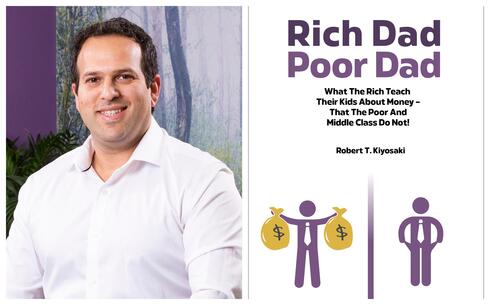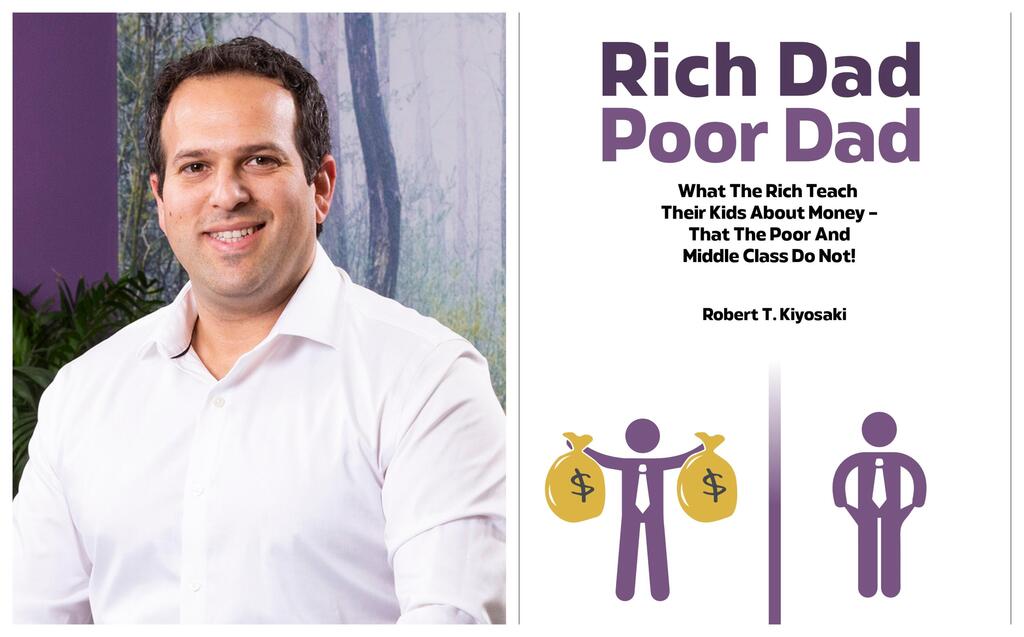
BiblioTech
CTech’s Book Review: Understanding the basics for Financial IQ
Yair Benyamini, Co-Founder and CEO at Lendai, shares insights after reading "Rich Dad Poor Dad: What the Rich Teach Their Kids About Money That the Poor and Middle Class Do Not!” By Robert Kiyosaki
Yair Benyamini is the Co-Founder and CEO at Lendai, a fintech direct lender financing U.S properties for foreign investors. He has joined CTech to share a review of "Rich Dad Poor Dad: What the Rich Teach Their Kids About Money That the Poor and Middle Class Do Not!” By Robert Kiyosaki.
Title: "Rich Dad Poor Dad: What the Rich Teach Their Kids About Money That the Poor and Middle Class Do Not!”
Author: Robert Kiyosaki
Format: Book
Where: Home
Summary:
Robert Kiyosaki, an American businessman and author, published the first version of the book “Rich Dad, Poor Dad” in 1997. Kiyosaki is well known to Israelis, especially business and real estate investors.
Interestingly enough, in the beginning, the book wasn't a bestseller. However, in the years before the internet revolution, it became a very popular book in Israel and when readers realized the value behind it, the book started gaining readers.
Thanks to Kiyosaki, the world’s middle class learnt and understood the secrets of creating passive income and gradually became interested in it.
The book walks through Kiyosaki's unique self-development process and the reader is taken on a journey of his life. When Kiyosaki was 9 years old, he was exposed to the ideas of rich people. In Hawaii, he learned with kids from wealthy families. Throughout the story, Kiyosaki is lost between two worlds: the world of his school’s rich kids and the world of his home and his dad. While Kiyosaki's biological father believes in government power to assist citizens, his rich father is an entrepreneur who believes in finding new ways to earn more money and hiring talented people for new initiatives to succeed.
According to the book, the poor and middle-class people work for money, while the rich don't. The main message here is: when you don't have to work for money all day, you own your time and can innovate or pursue your interests.
Important Themes:
Often, people want financial freedom. They want to be employed not for necessity, but rather for a passion for the job. Kiyosaki explains that most people give up on this goal because they believe it to be too difficult.
An individual who has a defined purpose for his career or is considering business ownership knows what he intends to accomplish in the future. Therefore, setting goals should be the first step. Due to its difficulty, many people give up on this goal. When people work for a living without setting direct goals, they forget those goals that they don’t stand a chance to achieve. During his time at Xerox, Kiyosaki founded his first company in order to accumulate properties and investments. Through these first steps he took to escape the rat race, he was able to succeed more and more in his position as an employee.
The book describes four types of people and proceeds to give examples of them, ways for promoting their financial goals, and how to promote their business. The first one is the employee who has a job, Kiyosaki explains why moving to the next quadrant, self-employed is an actual financial progress. After moving from the first quadrant, the next moves ahead would be much easier. The last and most respectful quadrant, where the rich ones can be found is the investor. Money works for the investor, not the investor for the money.
The most important basics for Financial IQ that everyone should know:
- Accounting - Understanding assets and liabilities and reading numbers.
- Investing - the basics of investing are money that generates cash flow.
- Understanding Markets - demand and supply rules. You must understand the basics of the economy.
- Knowing the specific laws of businesses - companies that understand the technical issues of accounting, investing and leverage might succeed more than other companies.
- Saving tax payments legally - companies can have advantages that private individuals cannot.
What I’ve Learned:
It takes time for readers to implement the insights they gain from this book since they are often influenced by their current environment and businesses. Moving to the position of investor and founder of a business was the only way out of the rat race for me. My Co-founders and I established Lendai not only to be one step closer to the investor quadrant, but rather to help other people reach this quadrant as well!
Investors around the world are following Kiyosaki's example and building their own real estate portfolios. With every new edition of the same old book, I learn more and more about Kiyosaki's ideas. Through Lendai, we are helping foreign investors finance their U.S real estate investment and thus allowing them to keep growing their profile. We are helping more people make their money work for them.
Critiques:
Although the book gives you specific suggestions on why and how to grow from your current position to financial success, it requires a strong mindset from readers and a great ability to implement those lessons. Not everyone is in the right self-development mode for that. So without taking personal risks as an investor or as an entrepreneur, you cannot implement the methods. It took me several years in the workforce to make the jump and become an entrepreneur.
Who Should Read This Book:
Even though this book was written 25 years ago, the book is as relevant today as it was when it was written. This is due to the ease with which new businesses can be established in the digital world: fintech, online, and e-commerce. In addition, the book has become even more practical due to the availability of digital tools for managing money and investment opportunities.
Accounting and financial basics are considered the province of CPAs. According to today's reality, this might have been the case in the past. Everyone should read “Rich Dad, Poor Dad” in a changing world that creates an ecosystem of innovation. Innovation cannot exist without a deep understanding of investing and finance.
Lastly, readers who believe financial knowledge is a basic need in today's world should read the book.














